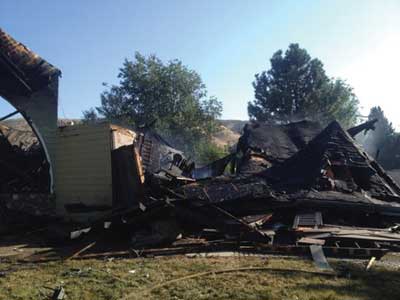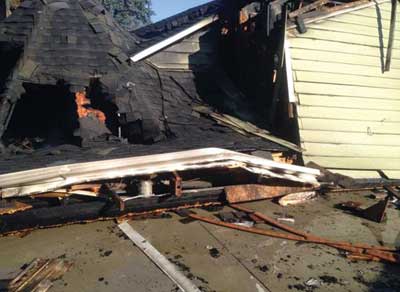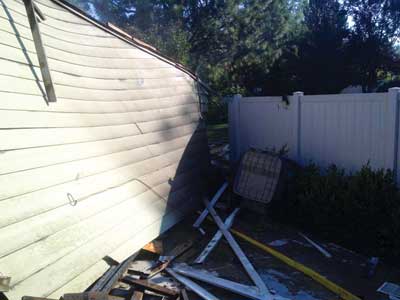BY AARON HUMMEL AND ROB CHRISTENSEN
PAGE 1 | FULL ARTICLE
Wind and Fire Containment
None of the firefighters on scene were aware that the structure had been vandalized two days before the fire. Vandals had plugged drains, turned on the water, and flooded the home. A restoration company had just removed much of the gypsum board throughout the structure to help the wood to dry out. This absence of gypsum board provided an incredible unabated fuel load for what would become a wind-driven event.
When the E-16 captain noticed the exposed studs in the garage during the incident, he believed this was the condition in just a small area in which gypsum board still had to be installed following the most recent renovation. Working on the Delta side, the E-16 captain said, “There were times when the wind appeared to stop.” In hindsight, he determined that it was likely that the surrounding fences, trees, and houses blocked most of the eye-level winds, giving him a false reading on how hard the wind was still blowing.
BC-2 and E-16 arrived on location two minutes behind E-9. BC-2’s initial concern was limiting the fire to the structure involved because the winds were estimated to be gusting at 15 to 20 miles per hour on his arrival. Hill Road winds (as in serpentines) along the base of the north Boise foothills extended several miles from northwest to northeast Boise. The thoroughfare is at the base of nearly a continuous wildland urban interface development upslope to the north. Many of the homes in older developments still have wood-shake roofs. The home involved was on the north side of Hill Road.
 |
 |
 |
 |
| (1-4) The aftermath of the collapse. Note the hoseline under the structure in photos 2 and 3. (Photos by Rob Christensen.) |
Span of Control, Rapid Intervention Team
E-9 transferred command to BC-2, advising that they were “defensive for now.” It was clear that this rapidly escalating incident would be a challenge at best. In anticipation of additional units arriving to assist, the IC began assigning tactical level supervisors to assist with maintaining an appropriate span of control. When the second BC arrived (BC-1), he was assigned as Fire Attack Group supervisor and was given E-9 and E-16 to manage. A couple of minutes later, T-5 and E-42 were added to the Fire Attack Group.
By this time, E-9 had extinguished the Delta exposure and was attempting to make access to the Charlie side of the main fire building, as fire had extended to the interior. E-2 was sent around to the west side, where Hill Road turned to the north, following the shape of the foothills. The E-2 captain was assigned as Division Charlie supervisor and was given E-5 and T-6. Division Charlie was assigned to protect the Charlie exposure and provide a size-up of both structural exposures and any wildland issues for the IC.
About this time, the IC noted a rapid change on the alpha side as fire quickly changed from being visible on the exterior to having extended from the first to the second and third floors on the interior. The swirling downslope tailwind aided in this extreme fire behavior. This is clearly visible in the full dash cam video shot from the IC’s command vehicle on Alpha. (http://bcove.me/4199w8i9) E-4, arriving on the second alarm, was directed to come to the incident command post (ICP) on the Alpha side. At the ICP, the IC assigned E-4 as the rapid intervention team (RIT), even though they were in defensive mode because of how fast things were escalating.
Seconds before the E-9 captain’s urgent transmission regarding the imminent collapse, the IC had reminded all units on the fireground that the attack on the main fire building was defensive. He reinforced the defensive strategy because he was concerned about structural stability. He could see that a firefighter operating a 2½-inch line on the Alpha side was too close. Command’s view of crews operating on the Delta side was obscured by the row of large trees on the east side of the driveway. After receiving the imminent collapse traffic, the IC clearly announced that all units were to back away from the structure and back up out of the collapse zone.
The collapse that followed nine seconds later was more extensive than anyone on scene had predicted. Judging from the reaction of the firefighters in the Alpha/Delta area, who were running toward the collapse, the IC feared that firefighters in the Fire Attack Group were unable to escape. The IC requested a second ambulance and tone alert for emergency traffic from the dispatch center. He began an emergency roll call, requested a third alarm, and activated the RIT (E-4).
Third Alarm, Knockdown
The third-alarm companies (E-6, E-10, E-1, T-7, and BC-3) were directed to Cynthia Mann Elementary School down the street for staging. While E-6 was managing staging, dispatch notified command that there was a roof on fire downwind to the south. After a complete roll call and, amazingly, just minor injuries after the collapse, third-alarm companies, led by BC-3, were directed to the roof fire on a separate radio channel.
Back at the Hill Road collapse, crews were positioned to operate 2½-inch lines around the structure to keep the embers down. Eventually, the winds died down, and companies were released. The IC scheduled a rotation to ensure that at least one crew remained on scene throughout the night to put out hot spots. Brush 1 was staffed and assigned to patrol a several-block perimeter for fire brands and hot spots; there were still intermittent gusting winds.
AFTER-ACTION REVIEW
One of the concerns facing firefighters was a situation they had experienced five years earlier on a significant incident. An incident, known as the “Oregon Trail Fire,” occurred in Boise on August 25, 2008, at 1900 hours. This was a wildland urban interface fire that was fueled by high winds, low relative humidity, and high temperatures. Sixteen homes were destroyed or significantly damaged; seven others received minor damage. Of the 23 total structures damaged, eight were a result of flying embers and not direct flame impingement. Aggressive defensive tactics on the Hill Road incident would prove important, as two other structures’ roofs caught fire during suppression efforts.
- Close call. Both E-9’s and E-16’s hoselines were found beneath the collapsed structure. BC-2 stated that he expected collapse at some point but did not expect it to occur so quickly or so globally. Crews operating on the Delta side were unaware of the advanced fire conditions in the rest of the structure, believing that the fire was isolated to where they were making their attack. Crews operating on the Delta side were also unaware that a master stream was placed in operation. From the IC’s location (dash cam), he did not realize crews on Delta were operating so near the structure when he gave the okay for the E-9 driver to flow it. In hindsight, the IC indicated that he should have requested a tone alert and announced to all crews operating on the fireground that a master stream would be going into operation. Three firefighters were injured (back, head, ribs) during the collapse, but none were transported to the hospital.
- Staffing. Most captains operating on the Delta side indicated that they were too hands-on, which limited their ability to step back, view the big picture, and maintain accurate situational awareness. The ability to accomplish numerous tasks at any rapidly evolving incident is hampered with only three-person engine staffing. Captains are not able to issue orders and observe visual and audio cues on the fireground when they are required to be so hands-on to accomplish an assignment.
- Review of emergency traffic and roll call. Shortly before the collapse, the E-9 captain transmitted emergency traffic regarding collapse. This transmission did not go through, as he was walked on by another transmission. The E-9 captain transmitted his message a second time using the term “priority traffic.” The IC ordered crews out of the collapse zone just prior to collapse. Emergency traffic would have been appropriate, according to BFD standard operating procedures. The IC requested a tone alert for emergency traffic from dispatch. Only a single beep of the tone alert came across the radio, resulting in Division Charlie companies missing the announcement of an emergency roll call. This resulted in Division Charlie interrupting the roll call to report the collapse. The roll call was initiated and completed in two minutes and 40 seconds. At the time of the collapse, the IC had not completed his tracking sheet and had to perform much of the roll call from memory.
- Apparatus placement. The E-9 captain indicated that he had considered pulling around to the Bravo side of the structure on E. Hill Road but opted to spot the apparatus on the Alpha side to position at a hydrant in the front yard of the residence. E-9 intended to have the second-in engine (E-16) spot on the Bravo side to stretch lines to the Charlie side. The E-9 captain didn’t realize that, because of the power line down call, E-16 was responding from the east rather than from its quarters to the west. E-16 ended up parking on the E. Hill Road side (Alpha) behind E-9. E-2 was then assigned to spot on the Bravo side. On arrival, T-5 spotted on the Alpha/Delta corner of the property. The T5 captain indicated that his apparatus placement was a deliberate decision to have his apparatus in an optimal position for aerial operations, if needed. As units from the second alarm arrived, E. Hill Road became congested as apparatus were not positioned to allow access for additional vehicles. East of the property on Hill Road was completely blocked. This could have been disastrous had firefighters been critically injured and ambulances needed access for transport to the trauma center. This also made response to the exposure fire at 5195 Holly Hill Drive difficult, particularly for BC-3.
LESSONS LEARNED
- Know what your fire is doing at all times. This rule is adhered to in wildland fires to ensure that changing weather or fire conditions don’t catch firefighters by surprise. This is not always possible in the structural environment, particularly when we are making an interior attack and our senses are limited. However, on defensive or exterior operations, fire officers should slow down and assess conditions frequently. On smaller house fires, individual officers can scout and size up what they are dealing with. Larger structures, like the Hill Road home and many commercial buildings, make it difficult to scout and size up the fire behavior. In these instances, it might be necessary to have division officers, BCs, or safety officers operating on specific sides of a structure to provide situational awareness for the IC and operating companies. Items for discussion include the following:
- Can you have an aggressive defensive position on a structure?
- Can you operate in the collapse zone on a defensive fire? If so, how can you help mitigate the risk?
- A 360° size-up is critical for situational awareness.
- Defensive operations should be conducted with consideration of collapse zones, exposure protection, and firefighter safety.
- Defensive operations require a different operational tempo than an offensive mode fire. We can still be aggressive, but we must proceed with extra consideration of situational awareness.
- Company officers must remain as hands-off as possible to maintain a view of the big picture on defensive operations.
- Exposed structural members will lead to rapid fire growth and early building collapse.
- Maintain discipline and composure at all times, as demonstrated on the fireground around the time of the collapse.
- Review performance measures with dispatch regarding tone alert, emergency traffic, and Mayday protocols to ensure proper fireground communications.
- Develop training focused on operational tempo, mindset, and situational awareness.
- BC-2 commented on the difficulty in getting a grasp on the incident in view of the excessive radio traffic of first-alarm companies reporting on location, making assignments, waiting for responses, and so on. BC-2 suggested preassignments for typical residential structure fires may have been beneficial at this incident.
- A battalion chief’s aide would have been very helpful during this incident.
AARON HUMMEL has been a career firefighter for 18 years. He is a battalion chief in charge of the 2nd battalion of the Boise (ID) Fire Department. He is credentialed through the state of Idaho to teach Brannigan’s Building Construction for the Fire Service. He has an AAS degree in fire science from Boise State University and is completing requirements for a BA/BS degree in management.
ROB CHRISTENSEN is in his 18th year as a career firefighter. He is a captain with the Boise (ID) Fire Department, where he is assigned to Engine 16. Previously, he worked three seasons with the Boise national forest, where he spent the majority of time with the Boise Hotshots. He is certified as a national wildland fire and wildland urban-interface instructor.
Fire Engineering Archives

